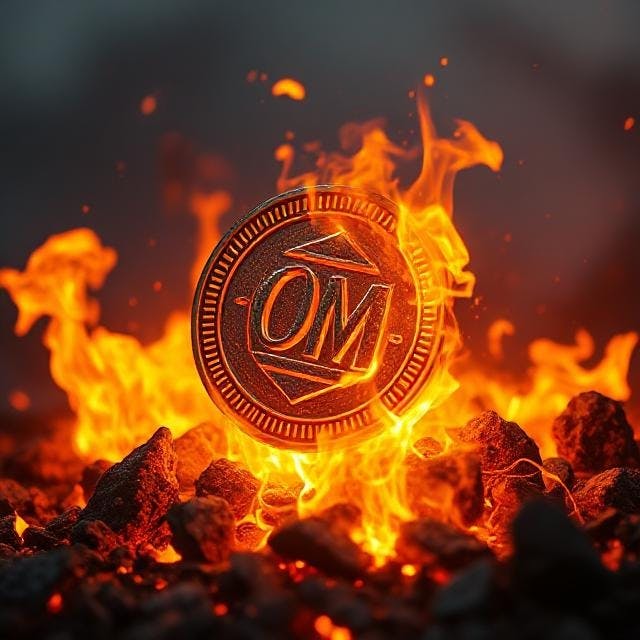On April 13, 2025, the crypto world witnessed another brutal token crash as OM, the token powering the Mantra RWAs ecosystem, dropped 90%, wiping out over $5 billion in market value and causing many investors significant losses. Though Mantra CEO John Patrício Mullin has attributed the crash to “massive forced liquidations” of large OM positions on centralized exchanges.
The sudden token plunge has left investors and experts alike scrambling to make sense of the situation, even though no confirmed reports of exploitation or hacks have emerged.
Was Mantra’s collapse a Coincidence or a perfectly staged token dump?
Mantra was designed as a layer-1 blockchain focused on bridging the TradFi and DeFi gap through tokenizing real-world assets (RWAs) such as bonds and real estate on-chain. Its utility token, OM, was used for gas, governance, staking, and accessing tokenized RWAs. The recent token sell-off began during low-liquidity trading hours and accelerated quickly due to a chain of liquidations of leveraged positions. Within a few hours, OM unexpectedly fell from $6.3 to $0.5.
However, signs of cracks and fragility in the project had already been surfacing for months. The Mantra Team had faced accusations of lacking transparency in their management of the project from their community. The team allegedly had access to over 90% of the token supply, conducted various OTC deals to sell tokens to investors at discounted prices, and repeatedly changed their distribution plans and allocation for the token airdrop to their users.
On-chain data also revealed that between April 7 and the time of the crash, about 17 wallets offloaded 43.6 million OM (approx. $227M) to Binance and OKX, which amounted to around 4.5% of the total circulating token supply. As selling pressure exceeded buying pressure significantly this period, the wave of sell-offs triggered a cascade of liquidations due to illiquidity, with over $ 71 million of OM positions liquidated within a few minutes.
Binance had also issued pop-up warnings of suspicious activity to its spot users because Mantra’s tokenomics had experienced substantial alterations, which increased its supply in the past months. These developments raised suspicion of strategic dumping and not forced liquidations as the cause of the sell-off to many users.
MANTRA Collapse vs Terra Collapse
The MANTRA 2025 collapse had striking similarities to the Terra’s Luna collapse in 2022. Many on-chain speculations, a rapid downturn spiral in price action, and suspicious team activities. However OM case seemed different as it has always positioned itself as a compliance-forward, RWA-focused blockchain. With tokenized real estate, KYC-aligned DeFi tools, and infrastructure targeting regulatory integration, OM had earned a reputation as one of the more credible tokens in the RWA space and hit an all-time high of $9.04 in February 2025. This creates a baffling thought on how a regulatory-compliant token plummeted so fast and so soon. OM’s centralized supply and thin liquidity were likely to be the reason for crash and this situation left a dent in investors’ confidence in the RWA industry.
Tracy Jin, the COO of MEXC, highlighted that this OM crash may feel like déjà vu for anyone who lived through the LUNA collapse.
“ Opacity and concentration of assets in the hands of a limited number of people led to a catastrophe. No sudden catalyst, no major exploit, low liquidity and a domino of forced liquidations. It’s a sharp reminder that low-volume hours can still create high-stakes wipeouts, especially when newer tokens start punching above their weight. What makes OM different is the institutional wrapper it came with. Tokenizing real-world assets, a $1 billion partnership withDAMAC, and a narrative around regulatory compliance gave OM an air of legitimacy,”
Implications for the RWA industry The OM crash comes at a time when the tokenization of RWAs is gaining momentum as a safer alternative to traditional bonds, with Tokeznized gold surging above a $2 billion market cap and total locked value of RWAs hitting a record $11 billion in Q1 of 2025 amid the heightened market volatility triggered by the geopolitical tension. Many viewed Mantra as a leader in this emerging space, which makes OM’s collapse a reputational blow to the broader RWA narrative.
“ The bigger issue is trust. When a token this high-profile crashes without a clear smoking gun, the community’s left stitching together conspiracy threads from on-chain data. The OM collapse is a wake-up call for the entire RWA tokenization sector, especially for projects seeking to position themselves as institutionally ready. When a token with a market cap of almost $6 billion loses 90% of its value in a few hours without a clear trigger, it destroys trust in the RWA approach itself,” Tracy Jin added further.
For investors and builders, the OM’s collapse is a reminder that institutional polishing and compliance wraps can not replace transparency and decentralization as the core requirements for the success of any project. Concentrating control of supply in the hands of a select few only builds a fragile system that can collapse like a pack of cards at any time.
In the wake of OM’s collapse, RWA-focused investors may need to revisit the basics to understand who controls the supply, what the liquidity maintenance mechanisms are, and how transparent the leadership is when things go south. Because even in a world tokenizing real-world assets, trust remains the most valuable currency of all.
The potential of the tokenized RWA remains undeniable, albeit investors will tread this path with more caution after this situation.











